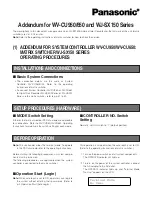
SERIAL CODE OPERATED SWITCH S-COS/2
10
A DTE (Data Terminal Equipment) device outputs data on pin 2 and receives data in on pin 3. Its
control output pins are (4) RTS and (20) DTR. Its control input pins are (5) CTS, (6) DSR and (8)
DCD. Terminals, personal computers, and DEC
™
computers are all examples of DTE devices.
Typical Configuration for the S-COS/2 to Appear as DTE
Switch
Positions Closed
A
5 and 8
B
2 and 3
A DCE (Data Communication Equipment) device is the opposite of DTE. It outputs data on pin 3 and
receives data in on pin 2. Its control output pins are 5 (CTS), 6 (DSR) and 8 (DCD). Modems, HP
®
computers, and DG computers are all examples of DCE devices.
Typical Configuration for the S-COS/2 to Appear as DCE
Switch
Positions Closed
A
6 and 7
B
1 and 4
S7 — M
ODE
2 T
IMEOUT
This 4-position DIP selects the amount of timeout delay when the S-COS/2 is in Mode operation (see
Section 4.1
on page 11). Close only one position of this switch at a time.
When the value for delay time is expressed in hex words, you can convert the figure to real time by using
the following equation:
((1/Y)
×
(X))/0.2 = T
Where:
Y = baud rate
X = word delay
T = time in seconds
Examples:
•
A 100-hex-word delay at 9600 baud equals a 52-millisecond delay.
•
A 100-hex-word delay at 4800 baud equals a 104-millisecond delay.
•
A 50-hex-word delay at 9600 baud equals a 26-millisecond delay.
•
A 50-hex-word delay at 4800 baud equals a 52-millisecond delay.
Timeout Delay when the S-COS/2 is in Mode Operation
Position Closed
Timeout Period
1
5 hex words
2
25 hex words
3
50 hex words
4
100 hex words
Summary of Contents for S-COS/2
Page 3: ......






































